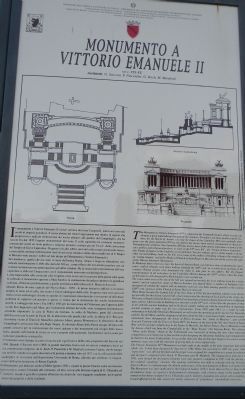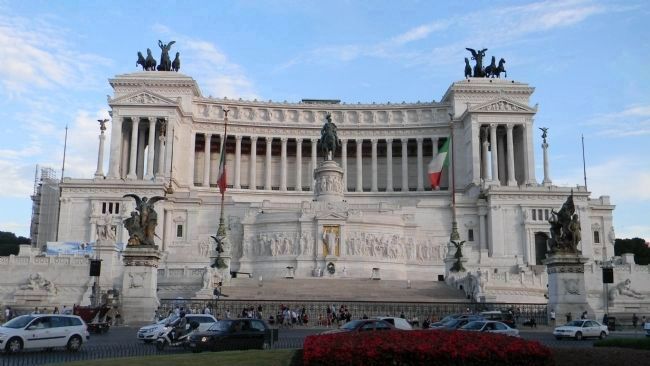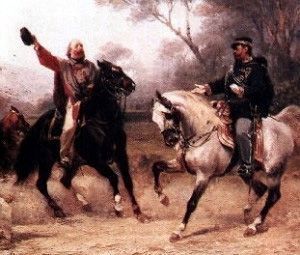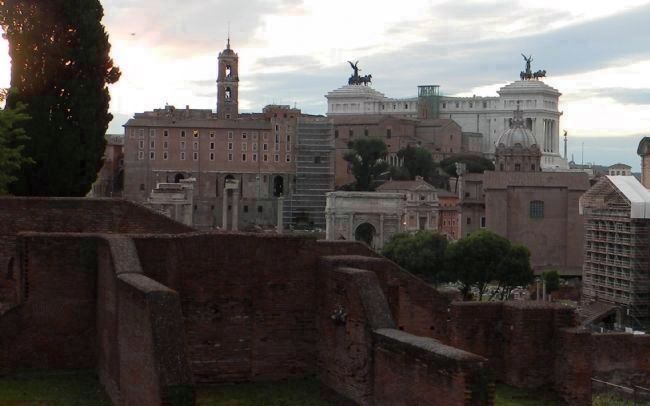Rione X Campitelli in Roma in Città metropolitana di Roma Capitale, Latium, Rome, Italy — Central Italy (Tyrrhenian Coast)
Vittorio Emanuele II
— [Capitoline Hill] —
Vittorio Emanuele II
secc. XIX-XX Architetti: G. Sacconi, P. Piacentini, G. Koch, M. Manfredi
Renderings of the Monument:
[Left column - Text in Italian…]
Right column - Text in English:
The Monument to Vittorio Emanuele IInd is situated in the Campitelli district which was the site of many great undertakings throughout the centuries. Nowadays, not many people actually live here, for the blocks of houses covering the slopes of the Capitoline Hill were gradually done away over areas and from 1870 on, the district has always been of the utmost importance in terms of the city’s politics and religious functions: as early as the VIth cent. B.C., the “Tepio di Giove Capitolino” (the Temple of Jupiter on the Capitol) was located here. Very few remains survive of this temple or of any other sacred buildings built on the hill, on account of the endless rebuilding schemes (the remains of an “insula romana” and of the Medieval Church of Saint Biagio in Mercato can still be seen to the right of the Vittorio Emanuele Monument).
In Medieval times what was once the heart of Ancient Rome was left in a state of abandon for many years; radical changes took place halfway through the XIIth cent. as a result of an uprising of the common Roman people who demanded the right to take part in city affairs. But the biggest transformation of all took place in the Capitoline District during the XVIth century when the great architectural works designed by Michelangelo were carried out.
The trapezoidal area at the top of the hill was opened up towards the west, making room for a large square, and an equestrian statue of Marcus Aurelius was placed there: a number of buildings were arranged all around the square and an immense stairway was built running parallel to the existing XIIIth cent. stairway of the Church of Santa Maria in Aracoeli.
When Rome became the Capital City of the New State in 1870, the first building schemes were drawn up specially for this district and its hill, which represented the ideological remains dating from all sorts of different ages, and so, when it came to building new structures in the 19th cent., all too often the question of what to do with the ancient buildings had to be faced, usually ending up with the demolition of important ancient remains to make way for new constructions. From 1885 until 1943, a result of work undertaken to build the Vittoriano Monument, as well as for the opening up of the Via dei Fori Imperiali and the Via del Mare, and the stripping of all trees from the hill,
a great many highly important artistic monuments have disappeared: the house of Pietro Cortona, the “Salita di Marforio”, part of the Aracoeli Convent with the Tower of Paolo IIIrd, the houses at the foot of the hill, the Church of Santa Rita (which was later rebuilt close to the Teatro di Marcello, the Altieri Palace, Piazza Montanara and the houses which ran from the Campidoglio to the “Rup Tarpea” (the Tarpean Rock). The colossal “Altare della Patria” (Altar to the Fatherland) was conceived of during the time when important competitions were being run to find architects for designing the illustrious buildings and monuments to be built for the newly Unified Italy. It was at this time also that architecture began to be used to create immense stage sets, with the intention of giving Italy its own original style.
The Vittorio Emanuele IInd Monument was built right in the middle of the most important hub of the whole city. It had been designed by Sacconi in 1884. When Sacconi died in 1905 the great, white “typewriter” was still not finished and the project was assigned for completion to a group of architects and designers composed of G. Koch, P. Piacentini and M. Manfredi. The inauguration took place in 1911, even though the decorative elements were only properly completed in 1927 with the placing of the sculpted “quadriga”
chariots. The opening celebration was held to coincide with the Universal Expo in Rome to commemorate the fiftieth anniversary of the proclamation of Rome as Capital City. The Monument was later dedicated to the Unknown Soldier (1921). It sits there in Piazza Venezia like an immense stage, set against a background of colonnades, with a bronze statue of the mighty King seated on his horse (sculpted by G. Chiaradia and E. Gallori), parading into action with a number of trusted officials by his side, amidst the stately structures of “propylaeae” and multiple staircases.
Erected by Ministero Per I Beni E La Attivia Culturali - Presidenza Del Consiglio Dei Ministri Dipartimento Del Turismo.
Soprintendenza Arceologica di Roma - Soprintendenza ai Beni Ambientali e Architettonici di Roma
Comune Di Roma – Assessorato alle Politche Culturali – Sovraintendenza Comunale ai Beni Culturali – Assessorato al Turismo e Giubileo
Azienda di Promozione Turistica di Roma.
Topics. This historical marker is listed in this topic list: Government & Politics. A significant historical year for this entry is 1870.
Location. 41° 53.72′ N, 12° 28.949′ E. Marker is in Roma, Lazio (Latium, Rome), in Città metropolitana di Roma Capitale. It is in Rione X Campitelli. Marker is at the
intersection of Piazza Venezia and Via di San Marco when traveling east on Piazza Venezia. Touch for map. Marker is in this post office area: Roma, Lazio 00186, Italy. Touch for directions.
Other nearby markers. At least 8 other markers are within walking distance of this marker. Vittoriano (a few steps from this marker); a different marker also named Vittoriano (within shouting distance of this marker); Museo Nazionale del Palazzo di Venezia / National Museum of Palazzo Venezia (within shouting distance of this marker); a different marker also named Museo Nazionale del Palazzo di Venezia / National Museum of Palazzo Venezia (within shouting distance of this marker); Auditoria di Adriano / Hadrian's Auditoria (about 90 meters away, measured in a direct line); a different marker also named Auditoria di Adriano / Hadrian's Auditoria (about 90 meters away); Chiesa di Santa Maria di Loreto / Church of Santa Maria of Loreto (about 120 meters away); Italian government officially recognized Czech-Slovakia (about 120 meters away). Touch for a list and map of all markers in Roma.
Also see . . .
1. Victor Emmanuel II of Italy. Victor Emanuel II (Vittorio Emanuele Maria Alberto Eugenio Ferdinando Tommaso; 14 March 1820 – 9 January 1878) was king of Sardinia from 1849 and, on 17 March 1861, he assumed the title King of Italy to become the first king of a united Italy, a title he held until his death in 1878. The Italians gave him the epithet Father of the Fatherland (Italian: Padre della Patria). (Submitted on September 4, 2011, by Richard E. Miller of Oxon Hill, Maryland.)
2. Wars of Italian Independence. (Submitted on September 4, 2011, by Richard E. Miller of Oxon Hill, Maryland.)
Additional keywords. Victor Emanuel II; 'Il Vittoriano'; Roman Forum; antiquities
Credits. This page was last revised on January 2, 2020. It was originally submitted on September 3, 2011, by Richard E. Miller of Oxon Hill, Maryland. This page has been viewed 987 times since then and 17 times this year. Last updated on September 21, 2011, by Richard E. Miller of Oxon Hill, Maryland. Photos: 1, 2. submitted on September 3, 2011, by Richard E. Miller of Oxon Hill, Maryland. 3. submitted on September 4, 2011, by Richard E. Miller of Oxon Hill, Maryland. 4. submitted on September 21, 2011, by Richard E. Miller of Oxon Hill, Maryland. • Bill Pfingsten was the editor who published this page.



